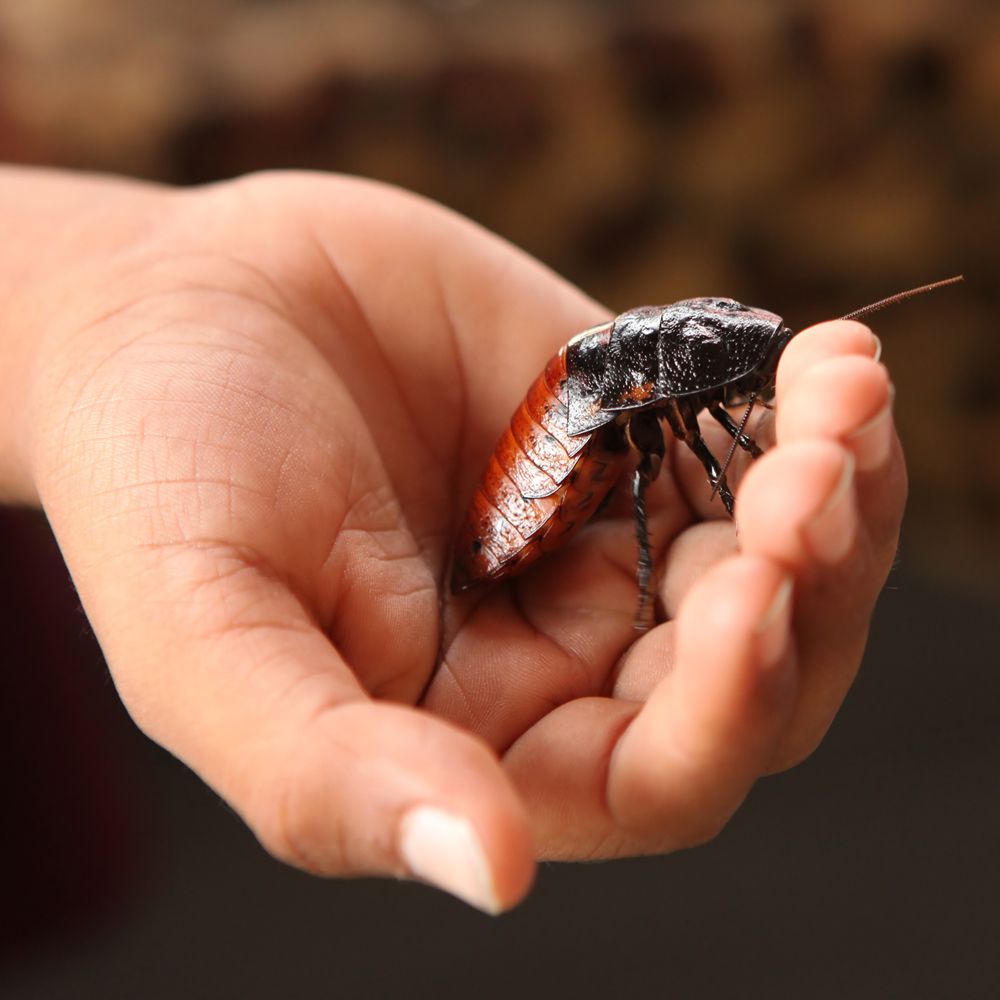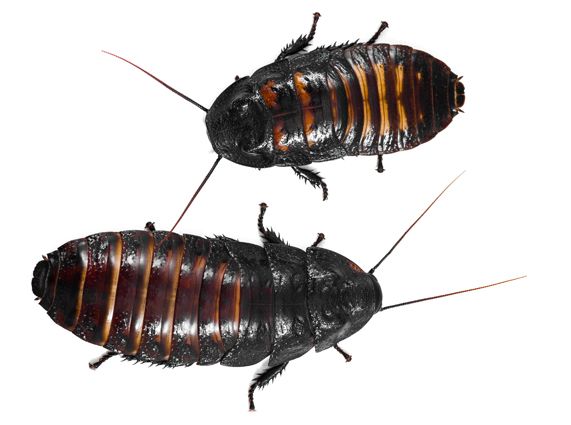My Cart
Your Shopping Cart is currently empty. Use Quick Order or Search to quickly add items to your order!

Angela Cruise
Product Developer
The Madagascar hissing cockroach is one of the most widely recognized exotic insects because of its large size and dynamic behavior. A staple in science museums and classrooms, it never fails to attract a crowd. If you have ever wanted to know more about this fascinating insect, keep reading.
To determine your hissing cockroach’s sex, first look at its prothorax. The prothorax is the dark, rounded region covering the head on the cockroach’s dorsal surface. If there are 2 large lumps, or tubercles, you have a male. If the prothorax is smooth and lacks the hornlike tubercles, you have a female. Note that some males have very pronounced tubercles, while others do not.
If you are unsure of your cockroach’s sex after looking at the prothorax, look at its antennae. Are they densely covered with tiny hairs toward the base? If so, you likely have a male; if not, a female. Female antennae are not as furry. This distinction is best seen if you have both a male and a female in your colony for comparison. If you have both, you may also find that the females are much more docile and easily held than the males.
As a side note, you may also notice that some of your cockroaches have damaged antennae. This is very common and nothing to worry about. These cockroaches naturally like to aggregate in large numbers, which can lead to breaks in the fragile antennae. Additionally, males will often fight over a female or a preferred territory (often a higher object in the cage) and damage their antennae in the process.
No! Hissing cockroaches have chewing mouthparts, but they are not strong enough to chew your finger. Also, these insects are extremely docile and not aggressive toward humans. The cockroach’s head is tucked under its body in a defensive rather than aggressive position. You can compare this with aggressive insects like stag beetles, whose heads are oriented facing forward.
While Madagascar hissing cockroaches cannot hurt you, students should be aware of the tiny spines on their legs that can cause an often unexpected tickling sensation when holding the insects. These spines help the cockroach cling to different surfaces and offer some protection from predators. They will not harm you.
This question is best answered by first explaining insect respiration. When humans inhale and exhale, air passes through the nostrils or mouth. Insects do not have nostrils (or a nose for that matter!), so how do they breathe? If you look along the edges of the dorsal surface of a hissing cockroach’s abdomen, you will notice a pair of tiny, dark circles on each segment. If you were to look at these darkened areas under a microscope, you would see tiny openings in the insect’s exoskeleton, or hardened body surface. These openings are the spiracles. It is through these openings that air enters and exits the insect’s body.
Rather than having a nose with only one pair of nostrils, insects have many pairs of spiracles along their body surface. When the hissing cockroach quickly forces air out of these spiracles, it creates a hissing sound. You can do something very similar. Try forcibly pushing air from your nostrils. Did you hear a sound? Just imagine what that would sound like if you had multiple pairs of nostrils!
Hissing cockroaches hiss for several reasons. The most common reason is that the cockroach has been disturbed. It then hisses to scare away whatever organism disturbed it. This disturbance hiss is performed by both males and females. Hissing is also used as a form of communication among male cockroaches within a colony. The frequency and tone of the hiss differs based on whether the male is dominant, subordinate, or ranked somewhere in between. Males also use hissing to attract females or to engage other interested males in battle over a female.
Hissing cockroaches can grow to about 3” long. You will likely notice that, unlike many of the more common types of cockroaches in the US, Madagascar hissing cockroaches never develop wings.
Hissing cockroaches eat decaying organic matter in nature. They survive well on a diet of fresh apple slices, vegetable slices, or even dry dog or cat food. Always be sure to provide the cockroaches with water, but never in an open container, as they could drown in it. Instead, soak a few cotton balls in water and place them in a bottle cap or other waterproof surface within the habitat.
Be sure to provide your hissing cockroaches with a dark place to hide. This could be a paper towel roll, an overturned paper egg crate, or a hollowed-out log. Hissing cockroaches prefer dark environments. Because of this, we recommend not placing your cockroaches in front of a window.
The tiny organisms crawling on your hissing cockroach aren’t bugs at all; they’re tiny mites. These mites will not leave the cockroach’s body. They help to keep it clean by consuming any saliva or organic matter that may build up on its surface. This helps to prevent mold or fungus growth on the cockroach’s body.
Yes! Hissing cockroaches are excellent organisms to keep in the classroom. They are easy and inexpensive to maintain, have a longer life span than many other insects, and provide students with the opportunity to learn through firsthand observation about insects, life cycles, and animal behavior. Additionally, the cockroaches are safe to handle. You may even notice that your cockroaches emit the disturbance hiss less frequently the more they’re handled.
While rare, it’s important to note that the development of an allergic sensitivity to cockroaches, including the Madagascar hissing cockroach, is possible. If you or your students exhibit any allergy symptoms (breathing difficulties, rash) when around or handling the cockroaches, discontinue all contact with the insects. This sensitivity can worsen with continued exposure. All individuals should wash their hands with soap and water after handling the cockroaches, even if no allergic sensitivity is noted.
No—you should not release hissing cockroaches into the wild. They are not native to the United States; releasing them could upset your local ecosystem. Hissing cockroaches are extremely low maintenance, so sustaining the colony during summer or winter break is as easy as providing them with some extra food and water and checking the supply once a week. Be sure to monitor sanitation within the habitat and exchange the egg cartons, paper towel rolls, or cotton balls/wick with fresh replacements as needed.
It is important to note that hissing cockroaches are not structural pests, meaning that they will not infest your house or classroom should they escape their habitat; however, they should never intentionally be released.

Male (top) and female (bottom) Madagascar hissing cockroaches
|
Scientific name: Gromphadorhina portentosa |